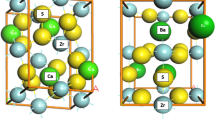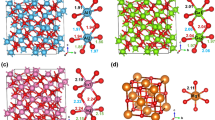Abstract
With the aid of ionic close packing ideal crystal lattices can be given to many distorted ionic crystal lattices. In consequence of distortion the actual lattices are mostly dilated compared to the ideal ones, so that the difference of the volumes associated with one anion of the actual and ideal lattice, respectively, is always satisfying the relation δV(X)≧0. For every group of ionic compounds with the same anion but different cations of the same valency and coordination number and only slightly differing ionic radii the difference volume δV(X) will be the same. With this supposition we were able to determine the ionic radii of the cations being present in rutile and its sister lattices and CaF2 lattices and further, the fact may be stated that for the cases revised here, mostly the ionic radii ofAhrens are most reliable. In the other cases,Goldschimdt’s radii or intermediate values of the two have to be regarded as the real ones. Some deviation can be found for the ionic radii in the case of the compounds AB2X6 in which the divalent cations are Fe, Co, Ni or Mn. An explanation for this will be given later. It could be stated that the ionic radii have rather a fictitious meaning and their values vary depending on the coordination number as well as on the influence of neighbouring cations, polarizability of the anions and on the relative number of cations and anions. The ionic radii redetermined in this paper are summarized in the tables, where also a comparison with the data ofGoldschmidt andAhrens is given.
Резюме
На основе принципа плотной упаковки ко многим реальным кристаллическим решеткам, которые почти всегда искажены, имеется возмоюность сконструировать неискаженную идеальную кристаллическую решетку. В результате искажения реальная решетка обычно больше идеальной, вследствие чего разность объема, падающая на один анион, δv(x) ≥ 0. В пределах каждой группы ионных соединений, состоящих из тождественных анионов, но из разных катионов, имеющих одинаковые валентность, координацию и ионные радиусы которых лишь мало отличаются, разность объема, падающая на один анион, получается одинаковой. Данное предположение дало возможность для повторного определения радиуса катионов, встречающхся в решетке рутила и родственных ему структурах, далее в решетке Ca F2, методом, отличающимся от применяемых по настоящее время. Из этого выводится заключение, согласно которому для ионных радиусов катионов, исследуемых в данном опыте, в большинстве случаев наилучшее приближение дают значения Аренса. В других случаях наиболее вероятными следует считать ионные радиусы Голдшмидта, или значения, отличающиеся от данных этими двумя авторами. Наблюдается некоторое расхождение у радиусов ионов в случае кристаллов состава AB2X6, в которых двухвалентным катионом является Fe, Co, Ni или Mn. Установлено, что ионные радиусы — скорее фиктивные значения, которые изменяются не тояько с изменением координационного числа, но и в зависимости от влияния соседних катиовов, поляризуемости анионов и от величины отношения числа катионов к числу анионов в кристаллической решетке. Определенные здесь ионные радиусы в сравнении с данными Голдшмидта и Аренса даны в таблице.
Similar content being viewed by others
References
J. A. Wasastjerna, Soc. Sci. Fenn. Comm. Phys. Math.,38, 1, 1923.
V. M. Goldschmidt, Geometrische Verteilungsgesetze der Elemente VII, Skr. Norske Vid.—Akad. Oslo. I. Math.—Nat. K. No. 2, 1926.
L. Pauling J. Amer. Chem. Soc.,49, 765, 1926.
W. H. Zachariasen, Z. Krist.,80, 137, 1931.
K. Stockar, Helv. Chim. Acta.,33, 1409 1950.
L. H. Ahrens, Geochmica et Cosmochimica Acta,2, 155, 1952.
K. Sasvári, Acta Phys. Hung.,11, 353, 1960.
I. Náray-Szabó, Naturwiss.,31, 466, 1943.
Landolt—Börstein, Zahlenwerte und FunktionenenBd 1/4, Kristalle, Springer Verlag, Berlin, Göttingen, Heidelberg, 1955.
A. Magnéli andG. Anderson, Acta Chem. Scand.,9, 1378, 1955.
N. Schönberg, Acta Chem. Scand.,8, 240, 1954.
Werner H. Baur, Acta Cryst.,9, 515, 1956.
J. W. Stout andStanley A. Reed, J. Amer. Chem. Soc,76, 5279, 1954.
K. Brandt, Arkiv Kemi, Min. Geol.,17 A, No. 15, 1943.
L. W. Vernon andW. O. Milligan, Texas J. Science,1, 82, 1951.
A. Byström, B. Hök andB. Mason, Ark. Kemi, Min. Geol.,15 B, No. 4, 1941.
I. Náray-Szabó Crystal Chemistry (in Hungarian), Budapest, Mérnöki Továbbképző Intézet, 1944.
K. Dihlström, Z. anorg. allg. Chem.,239, 57, 1938.
E. Tavora andF. Peixoto An. Acad. Brazil Cienc.,23, No. 4, 449, 1951.
A. Magnéli, Acta Chem. Scand.,11, 28, 1957.
A. J. Zaslavskij, Ju. D. Kondrasov andS. S. Tolkacev, Dokl. Akad. Nauk. SSSR.,75, 559, 1950.
A. Magnéli, Ark. Kemi, Min. Geol.,15 B, No. 3, 1941.
Author information
Authors and Affiliations
Rights and permissions
About this article
Cite this article
Sasvári, K. On the determination of ionic radii. Acta Physica 11, 333–351 (1960). https://doi.org/10.1007/BF03160431
Received:
Issue Date:
DOI: https://doi.org/10.1007/BF03160431




